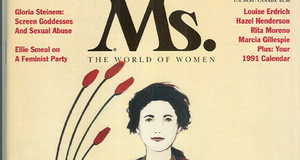The Shock Value of the SCUM Manifesto
By
2011, Vol. 3 No. 10 | pg. 1/1
KEYWORDS:
In 1967, Valerie Solanas wrote and self-published the SCUM Manifesto, which called for male gendercide and the creation of a superior, all-female society.1 This radical manifesto declared that women must “overthrow the government, eliminate the money system, institute complete automation, and destroy the male sex” (Solanas). Sold by Solanas on the streets, it came during a supposedly progressive era at the close of the civil rights movement and the emergence of the anti-war movement. Because of articles like “How to Be a Good Housewife” and television shows like Leave It to Beaver from the 1950s, however, society still expected women to remain at home and nurture their families. Shortly after her self-publication, Solanas shot and almost killed Andy Warhol, causing even more people to spurn her as insane. Nevertheless, readers cannot simply dismiss her manifesto as a crazy woman’s tirade. Along with a systematic use of obscenity, her seemingly absurd statements actually build toward a specific motive: to shock both men and women out of complacency with society’s sexism. Through her aggressive factual claims and calls to action, Solanas provokes her audience into challenging and acting against society’s unfair restrictions on women and narrow-minded notions of gender. By presenting and analyzing aggressive factual claims, Solanas boldly reverses traditional views and appalls the reader into challenging society’s unjust attitudes toward women. After degrading men’s uselessness, she contends, “Women, in other words, don’t have penis envy; men have pussy envy” (Solanas). Contradicting one of Sigmund Freud’s famous theories, Solanas leads the reader to believe that men actually envy women. Her assertion seems brash and irreverent, but she uses her knowledge in psychology to establish credibility (she received a bachelor’s degree in psychology from the University of Maryland and did almost a year of graduate work at the University of Minnesota). In addition, Solanas divides her manifesto into sections that show how men control society and disempower women. For instance, in “Philosophy, Religion, and Morality Based on Sex,” she argues that for men, “‘wrong’ is sexual ‘license’ and engaging in ‘deviant’ ‘unmanly’ sexual practices” while for women, according to men, “‘wrong’ is any behavior that would entice men into sexual ‘license’” (Solanas). The quotations around words like “wrong” reveal Solanas’s sarcasm and distaste for societal principles. Even though men desire sex, they criticize women for offering it, and since they cannot have sexual freedom, they do not allow women to have any either. By identifying this injustice, Solanas urges her audience to question not her rationality, but that of society’s sexism. Solanas espouses radical factual claims to push her readers into disputing the unfairness toward women, but takes large risks to do so and may offend them instead. Although Solanas takes a large risk in presenting her claims, she does provoke the reader into reevaluating society’s established gender roles. Her contention about men having “pussy envy” contradicts accepted theory and is especially radical since people viewed Freud as an iconic figure. By completely reversing his theory and putting men on the defensive, Solanas overturns his credibility and replaces it with her own. The use of the word “pussy” seems uncalled for because of its vulgarity, which, on the surface, would not work for a woman who is trying to persuade people to join her movement. But the statement does have a reason behind it, as the mere shock value invites the reader to consider an entirely different yet equally plausible viewpoint. In addition, Solanas’s claims are astute observations of society. Critics may dismiss them as ludicrous and offensive since they seem to attack men for wronging women, but her assertions do contain truth and rationality. In her sexual “license” argument, she affirms that men often blame women for “loose” behavior to cover up their own sexual misconduct, and historically, evidence does support her. As a result, readers would have difficulty disagreeing with Solanas’s argument and will dispute the integrity of society’s sexism. This injustice would especially outrage and frustrate female readers, and such emotions are the greatest catalysts for taking action. With unconventional claims, Solanas impels her readers to reject conventional beliefs of gender, and as a result, she can instigate them into action against sexism.Having established her claims, Solanas promotes radical approaches to the male problem so that her audience can oppose society’s unjust treatment of women. To appeal to the reader’s desire for excitement, she romanticizes SCUM’s platform by declaring, “But SCUM is impatient; SCUM is not consoled by the thought that future generations will thrive; SCUM wants to grab some thrilling living for itself” (Solanas). The three consecutive sentences without a pause in between, along with the word “impatient,” creates a sense of urgency for the readers to take aggressive measures instead of waiting for a better future. Furthermore, the phrase “thrilling living” pushes readers to imagine living adventurously, courageously, and spontaneously, in contrast with the boring, self-satisfactory lives they currently lead. In championing SCUM’s courses of action, Solanas points out that SCUM will not feel satisfied with inclusion in society. She proclaims, “SCUM will always operate on a criminal as opposed to a civil disobedience basis… SCUM is out to destroy the system, not attain certain rights within it” (Solanas). She references the current social movements (civil rights, anti-war) and suggests that they are, though well intentioned, not a convincing model for SCUM. Thus, she tries to jolt her audience out of naïvely following peaceful procedures and into considering more violent, straightforward ones. To turn readers against society’s unfair limitations on women, Solanas advocates revolutionary tactics, which are just as extreme as her claims and may alienate readers instead of inspiring them. Overcoming the unpredictable consequences of her calls to action, Solanas prompts the reader to rebel against society’s narrow-minded views of gender. The characterization of SCUM as “impatient” and wanting “thrilling living” has much less vulgarity than her assertions, thus reminding the audience to balance rationality with intense emotions. Solanas’s selectivity in language shows that she does in fact employ logic. She stimulates the reader’s indignation and resentment so that they overcome self-satisfaction and listen to a solution. In addition, Solanas’s promotion of crime as a way to impact society may seem irrational, but she uses it to achieve her objectives most directly. Readers may feel uncomfortable with crime, but just by contemplating it instead of peaceful protest, they essentially become members of SCUM. Although they may not use such extreme tactics, they are nonetheless dissatisfied and open to forceful methods. Even without vulgarity, Solanas encourages women, especially those who feel wronged by men, to fight injustice and repression. In her bold calls to action, Solanas dares her audience to rise out of complacency and to reassess society’s restrictive gender roles. By effectively using aggressive factual claims and calls to action in her revolutionary SCUM Manifesto, Valerie Solanas shocks her audience out of complacency with society’s sexism and into action against it. While her manifesto is undeniably radical and obscene, she systematically exploits those qualities, appealing to emotions, credibility, and logic to reveal the disempowerment and injustice of women. Thus, as Solanas advocates for male gendercide and an all-female society, she effectively pushes both genders to reexamine their attitudes toward the unjust treatment of women and restrictive gender roles. Though deemed insane at the time, the SCUM Manifesto not only added to the genre of shock literature, but also contributed to the second-wave feminism of the 1970s, during which women achieved milestones like Roe v. Wade (1973), which gave them the right to an abortion, and Title IX of the Education Amendments of 1972, which ended sex discrimination in high schools and colleges. The SCUM Manifesto also fits the context of the present third-wave feminist movement, which encourages sexuality, individual empowerment, and “unfeminine” emotions like anger and outspokenness. Today, readers generally qualify the manifesto as a satire, but young women, especially those who understand Solanas' frustration, will still admire her enormous nerve and rebelliousness. 1.) Much speculation has surrounded the meaning of the SCUM. Many sources, including The New York Times, have interpreted the word as an acronym for “Society for Cutting Up Men,” but the phrase, which Solanas rejected, does not appear in her work. In the manifesto, Solanas refers to particular women who constitute the so-called “scum” of society but serve as the core of her movement. According to her, they should act like “dominant, secure, self-confident, nasty, violent, selfish, independent, proud, thrill-seeking, free-wheeling, arrogant females” (Solanas). Suggested Reading from Inquiries Journal
Inquiries Journal provides undergraduate and graduate students around the world a platform for the wide dissemination of academic work over a range of core disciplines. Representing the work of students from hundreds of institutions around the globe, Inquiries Journal's large database of academic articles is completely free. Learn more | Blog | Submit Latest in Women's & Gender Studies |


















